Recently, I shared a guide for creating your own Zigbee mmWave presence sensor using an ESP32-C6 board and a Hi-Link LD2410C radar. The project is still in active development, which I believe can become a good base for building Zigbee devices based on Espressif’s C6 and H2 dev boards.
If you have ever gone down the mmWave rabbit hole, you already know the two most used frequencies for home automation radars are 24 GHz and 5.8 GHz. Both come with their own pros and cons, but 24 GHz usually takes the win. It offers a better balance of detection accuracy and penetration, making it more reliable in everyday smart home scenarios.
Now, 60 GHz mmWave radars are rare but still available, with one prominent example being the flagship Aqara FP2. 60 GHz radars are more advanced compared to 24 GHz and 5.8 GHz units, offering extremely fine resolution and the ability to detect very subtle movements such as breathing or tiny hand gestures. This higher frequency enables precise zone-based presence detection, making them ideal for complex automations like breathing and fall detection, zone triggers or multi-person tracking.
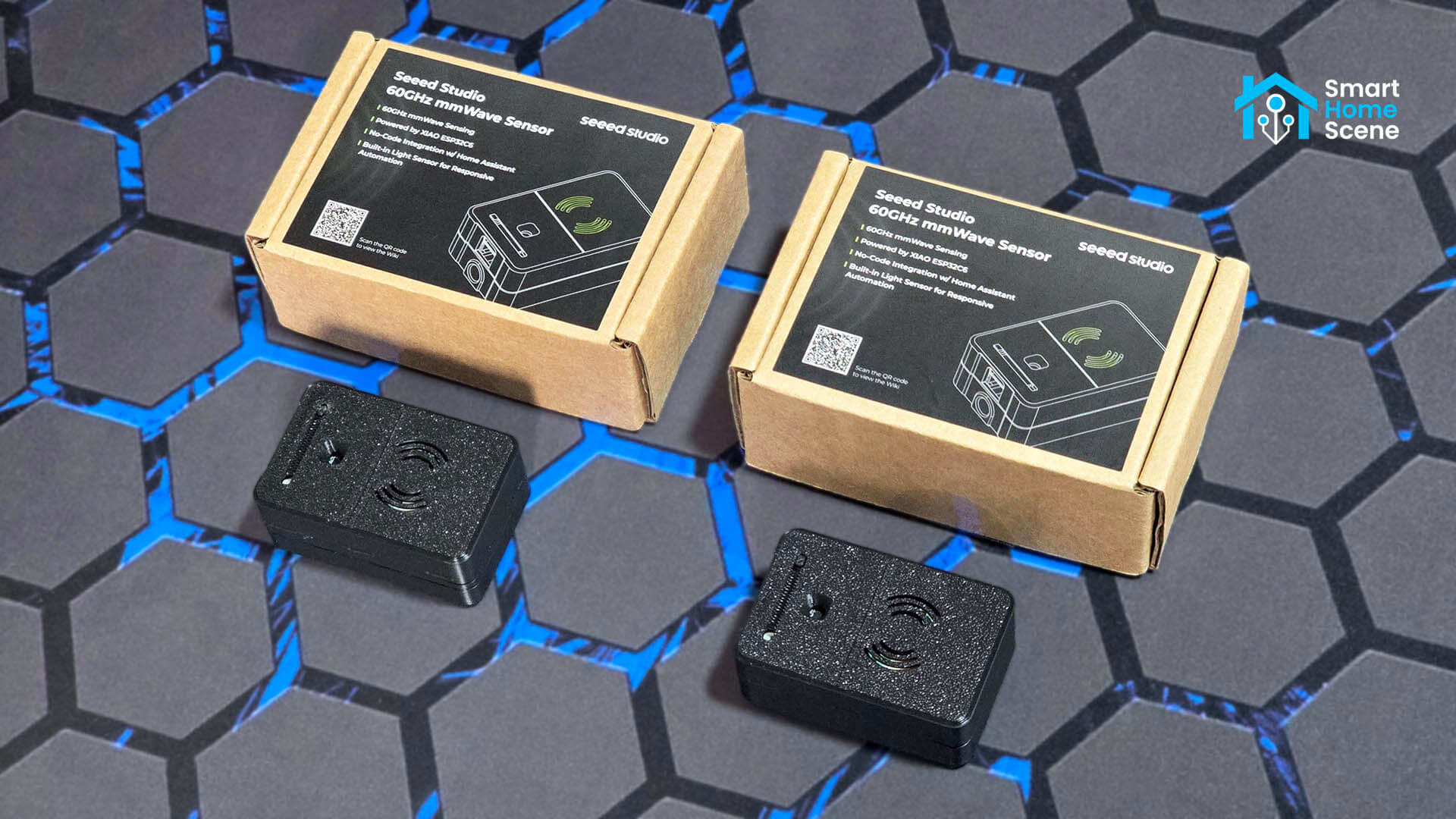
In this article, I’m sharing my experience with two such sensors from Seeed Studio: the MR60FDA2 and MR60BHA2. The first is a fine-tuned fall-detection sensor capable of detecting human presence at a maximum range of 6 meters, while the second is specialized for breathing and heartbeat detection with a range of up to 1.5 meters.
Both devices are based on the XIAO ESP32C6 board and work officially with ESPHome. You can get them on Amazon [FDA2, BHA2], AliExpress [FDA2, BHA2] or their official Seeed Studio Store [FDA2, BHA2].
MR60FDA2 vs MR60BHA2
While these two 60GHz sensors are fairly similar, they are obviously fine-tuned for different purposes. Becase of this, some functionality is sacrificed on one device compared to the other an visa versa. Here is a table of their their technical specs:
| Parameter | MR60FDA2 | MR60BHA2 |
|---|---|---|
| Primary Function | Fall detection, static human presence | Breathing, heartbeat detection, static human presence |
| Static presence detection range | Up to ~6 m | Up to ~6 m |
| Vitals detection range | / | Up to ~1.5 m |
| Fall detection volume | ~3×3×3 m volume | / |
| Field of view | 120°×100° | 80°×80° |
| MCU / Platform | XIAO ESP32C6 | XIAO ESP32C6 |
| Ambient sensors | BH1750 light sensor | BH1750 light sensor |
| Interfaces / expansion | Grove I/O, GPIO, UART / I2C / SPI | Grove I/O, GPIO, UART / I2C / SPI |
| Power Supply / Consumption | 5V input, ~0.5W standby, ~0.8W active | 5V input, ~0.5W standby, ~0.8W active |
| Deployment / mounting notes | Top-mount at 2.2–3.0 m; ~2 m radius; avoid reflections/glass/vibrations | Mount ~1 m above subject or tilt 45° toward chest; works best when still |
Devices Overview and Disassembly
The Seed Studio MR60FDA2 and MR60BHA2 sensors are encased in a 3D printed enclosure which contains the Xiao ESP32-C6 mini board, an expansion PCB with the mmWave sensors and an external antenna attached to the top cover. The external antenna to boost signal strength is a nice addition for a sensor of this type, especially considering the 2.4GHz band is quite polluted in a typical home environment.
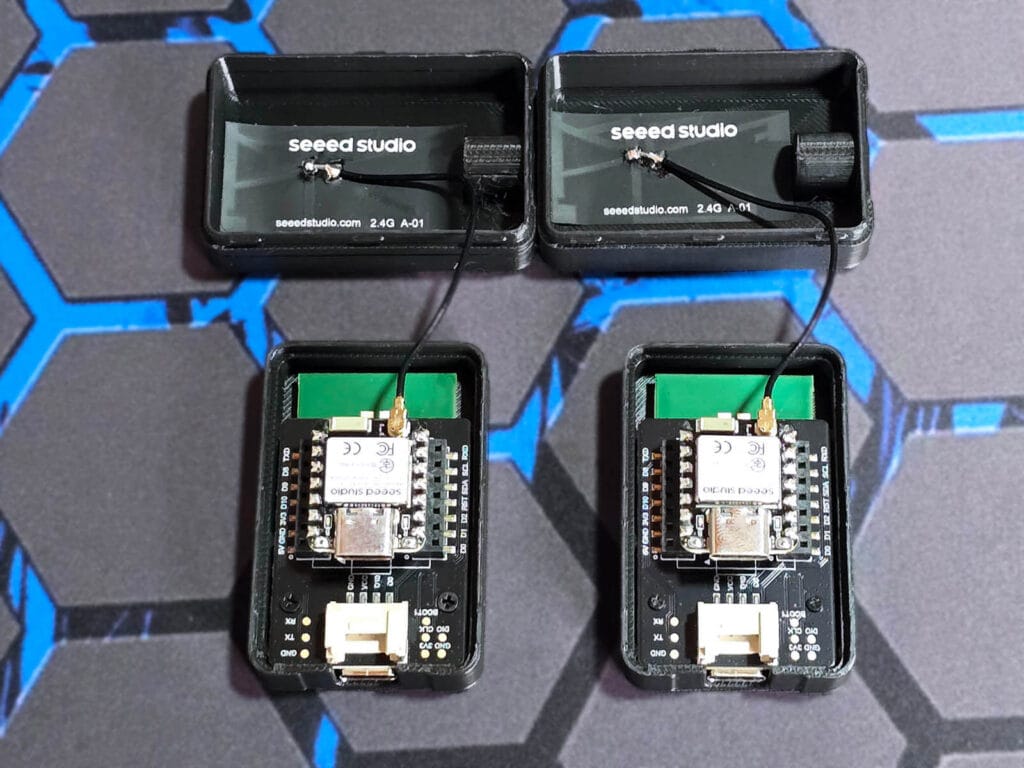
This is even more impressive when you consider the size of the Xiao ESP32C6 board. It’s even smaller than the ESP32-C3 SuperMini that I’ve been using as a Bluetooth proxy, measuring just 21 × 17.8 mm. Seeed Studio managed to fit an antenna connector on there, which is incredible for such a tiny board. Or maybe I’m just too easily impressed.
These mmWave radars actually have two USB-C ports: one is used for power, while the other is for flashing the ESP32C6 board. When you update or change the ESPHome firmware, you need to connect through the USB-C port on the ESP32C6 board itself, not the one on the bottom of the sensor.
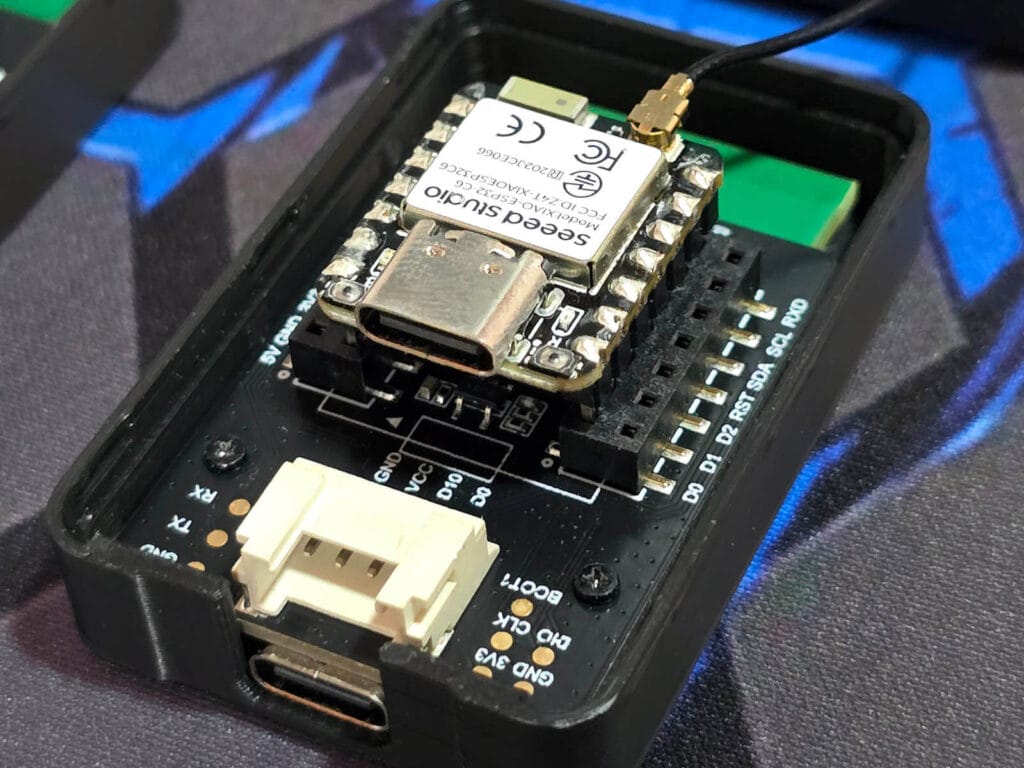
Furthermore, the devices include a Grove I/O port (1 GPIO) that can be used for external sensors or peripheral modules, such as relays, LEDs, or switches. This allows you to expand functionality beyond presence or vital-sign detection and integrate the radar into broader smart-home automations.
The ESP32C6 boards slot into place on the main PCB, which carries the mmWave radar module and a pair of 2.54 mm female expansion headers that expose the ESP32C6’s pins. Through these headers you get direct access to power rails, GPIOs, and communication lines such as UART, I²C, and SPI.
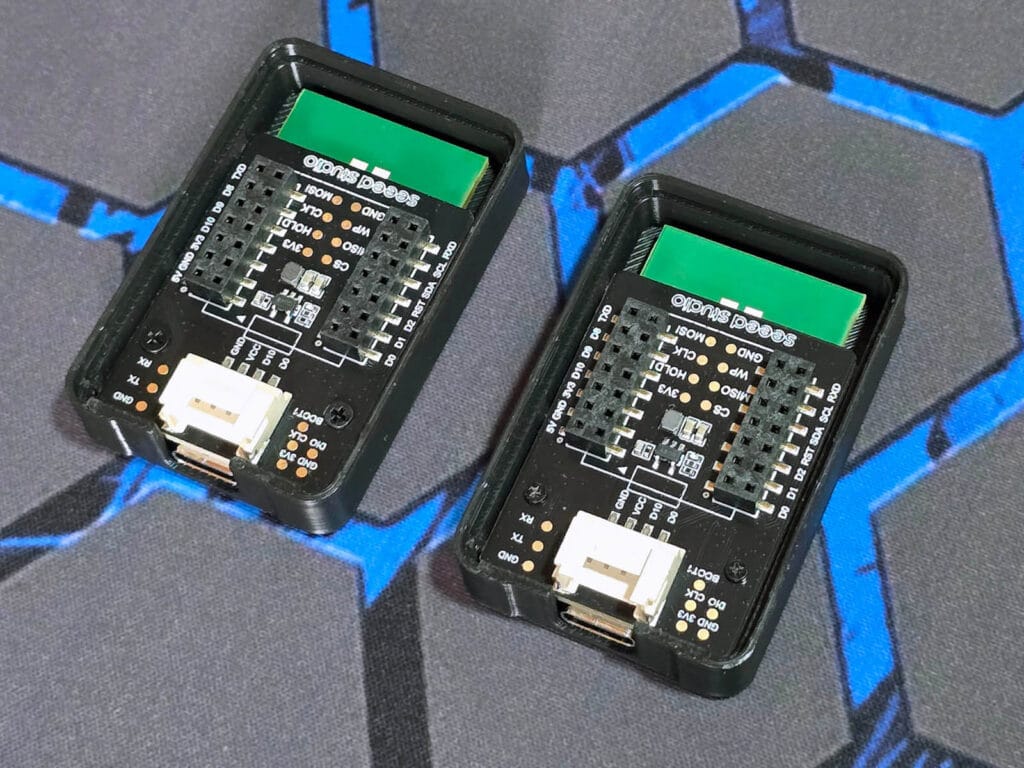
The 60 GHz radar modules themselves are unfamiliar to me and I have never encountered them before. Each board has a pair of flat patch antennas printed directly onto the PCB, one for transmitting the other for receiving, forming a small phased array for precise detection of movement, distance, and vital signs.
Interestingly, the modules are not actually made by Seeed Studio. They’re produced by a company called Andar Technology, which appears to be a millimeter-wave radar chip manufacturer headquartered in Hangzhou, China. I wasn’t able to find detailed information for the company or spec sheets for the sensors, but I did notice that the two use different chips.
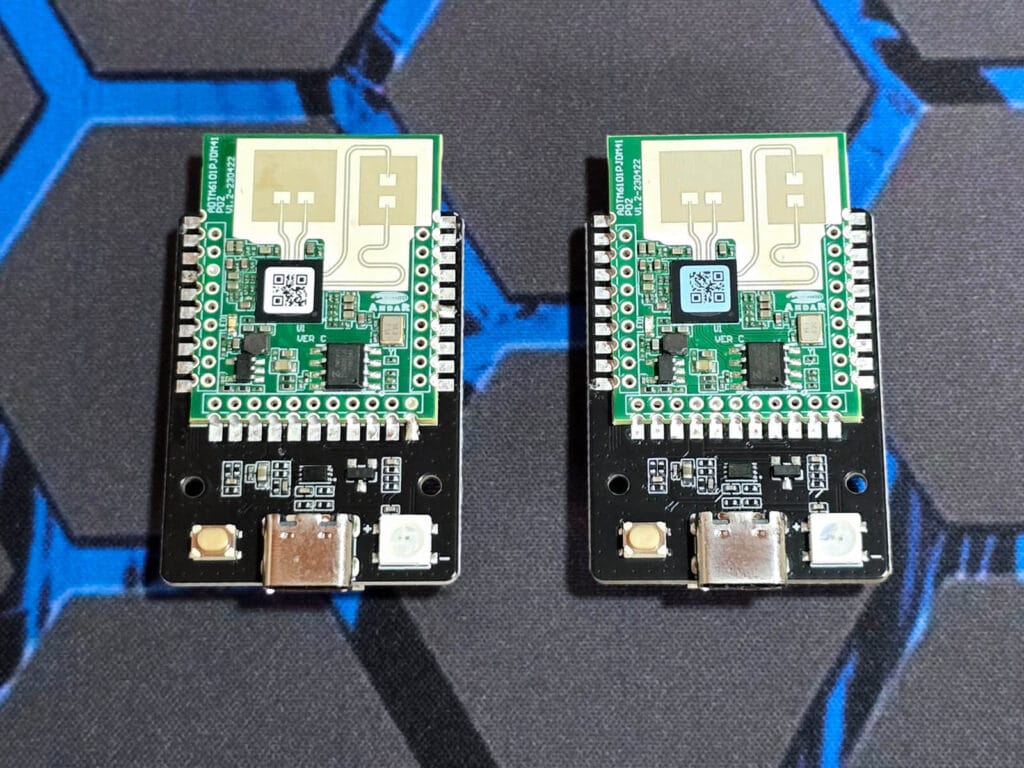
The FDA2 is fitted with a chip labeled DM2419, while the BHA2 carries one marked JB2437. This seems to be the key difference between the two modules, and likely the factor that tunes each sensor for its intended function, fall detection in the FDA2, and breathing and heartbeat monitoring in the BHA2. Overall, the devices are well built and without any noticeable pitfalls.
Home Assistant Integration
Since both these devices come pre-flashed with ESPHome, you can onboard them to Home Assistant very easily. You power them on, connect to the fallback hotspot they emit, input your Wi-Fi credentials and add them to Home Assistant. If, for some reason, you need to reflash the ESPHome firmware:
- Open the Seeed Studio Web Flasher
- Connect the sensor to your PC
- Note: Connect to the USB-C port on the ESP32C6 directly
- Flash the firmware
- Done
Once the devices are onboarded to Home Assistant, this is what you get for each:
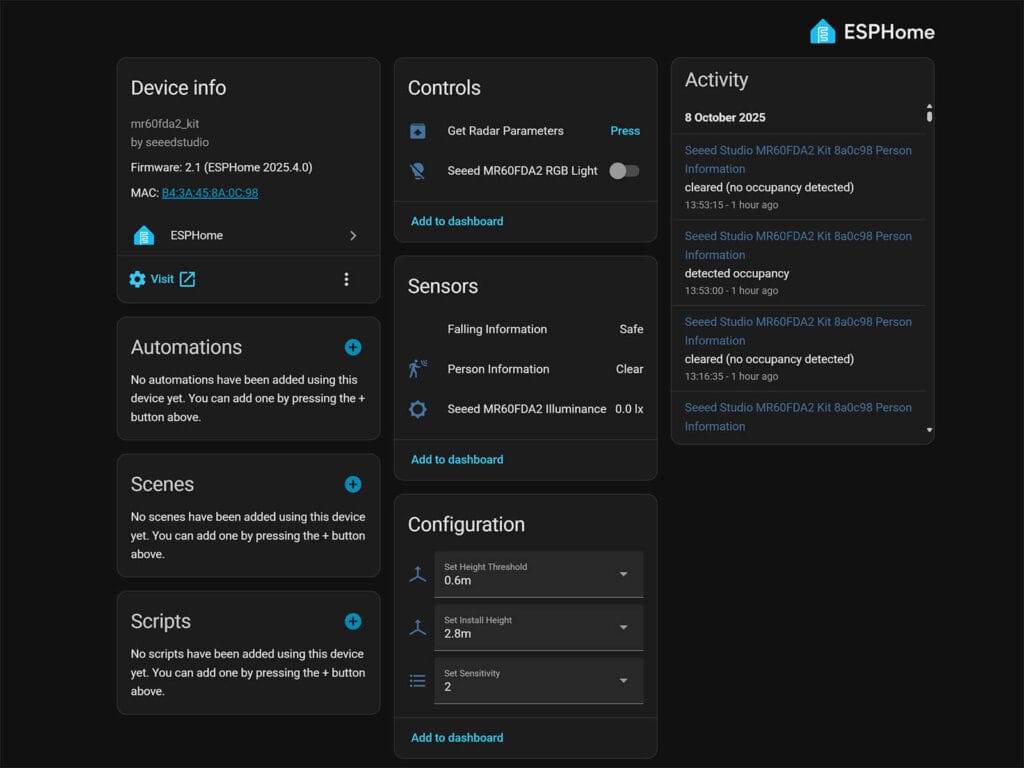
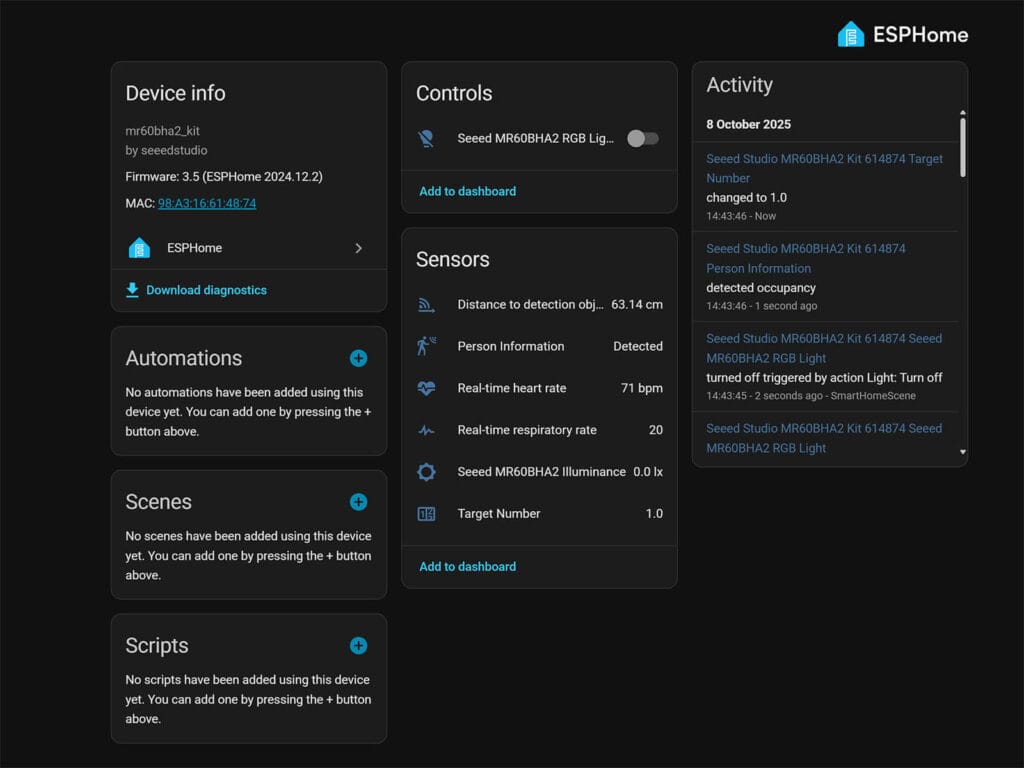
The MR60BHA2 exposes a distance sensor that shows how far away the target is, a person information sensor for presence, and two real-time sensors for heart rate and breathing rate. It also reports light levels through its built-in illuminance sensor and shows a target number for how many people are detected.
The MR60FDA2 exposes a falling information sensor that reports whether someone is safe or has fallen, along with a person information sensor for presence. Like the BHA2 it includes an illuminance sensor for light levels. This module also has a few configuration options such as setting the height threshold, the install height, and the sensitivity level.
Regarding the firmware, this is where the good news ends, unfortunately.
About Seed Studio’s Firmware
To my surprise, Seeed Studio decided it was a good idea to lock down the firmware that actually runs on these radar modules. The ESP32C6 side of things is open and customizable through ESPHome, which means you can edit the YAML configuration, add sensors, or integrate it with Home Assistant just like any other ESPHome device. But the 60 GHz radar module itself runs closed firmware that handles all the signal processing and sends out pre-digested results.
What this really means, in practice, is that you cannot dig into the radar’s brain, change its detection algorithms, or get raw radar data. You only receive whatever information the module has been programmed to provide, such as presence, fall events, or vital signs. For hobbyists this is usually enough, but it also feels restrictive when you realize the hardware is clearly capable of more than what is exposed. I mean, 60Ghz can do so much more, including zone definition.
Seeed claims this approach is necessary because the radar firmware is proprietary and not open source, with deeper access reserved for enterprise customers. For us regular users the end result is that we are limited to the functions already built into the module. You can build great automations around them, but you cannot redefine how the radar interprets its signals or repurpose the 60 GHz sensor and expand its functionality. The datasheets of the sensors can be found here: MR60FDA2, MR60BHA2.
Performance Testing
With that said, these mmWave radars seem very well tuned for the purposes they were designed for. I tested both in my office and the results were impressive and consistent. Since this was my first time trying a breathing and heartbeat mmWave sensor, I was genuinely surprised by how accurate it turned out to be.
I gave both sensors to Gandalf, who held them for me and did some benchmarks:
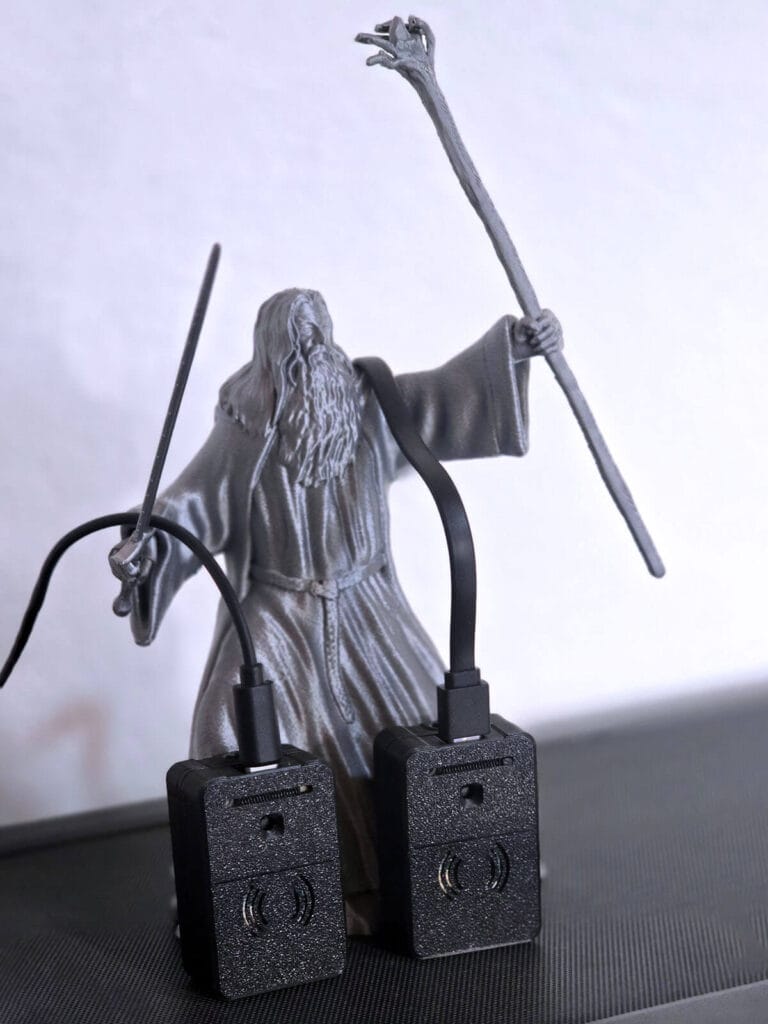
When detecting a person, both sensors responded in about one second. The FDA2 held the presence state longer, taking around ten seconds to clear once the person left, while the BHA2 cleared more quickly at about five seconds. I also found that the BHA2 is not triggered by small movements such as waving a hand. It needs to see a face or body to register presence, making it more selective but less sensitive to casual motion.
Fall detection on the FDA2 triggers when a person’s body drops below the configured threshold height. In my tests I managed to trigger it by making a sudden movement toward the ground, where the sensor detected my body dropping to around sixty centimeters from the floor and reported it as a fall.
But what surprised me most was the accuracy of the heart rate readings on the BHA2. I cross-checked the results against my Garmin watch, and the values stayed on par at a distance of about one meter from the sensor. The difference was only one to two percent, which is impressive for a radar module. The sensor also reports real-time respiratory rate, which is the number of breaths per minute measured from chest movements. I compared this by manually counting my breaths, and the values lined up very closely, showing that the sensor was spot on.
Final Thoughts
The Seeed Studio 60 GHz mmWave radar sensors proved to be accurate, reliable, and very well tuned for the purposes they were designed for. The BHA2 in particular impressed me with how precise the heart rate and respiratory rate readings were, showing just how optimized it is for tracking a person’s vital signs.
It should be clear by now that these modules are not your typical mmWave presence sensors for home automation. Instead, they are made for elderly care, health monitoring, or situations where you need to keep a close eye on someone’s well-being and react quickly if something goes wrong. For that use case, I believe they can be trusted to deliver.
If your goal is simple motion or presence detection to keep the lights on, then you’ll be better off with other options such as the Apollo MSR-2 or the R PRO-1, both of which I’ve tested extensively and still use every day. But if your use case aligns with what the MR60BHA2 or MR60FDA2 are built for, they are a great choice.
I’m not sure how I feel about Seeed Studio’s decision to lock down the radar firmware. It definitely limits flexibility and is something to consider when making your decision. If you do not need to expand functionality beyond what’s available, I truly believe these 60 GHz will not let you down.
Here’s where you can get them:
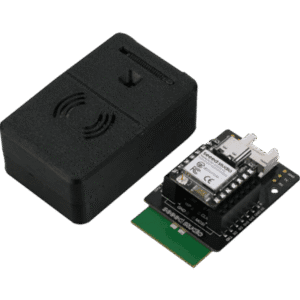
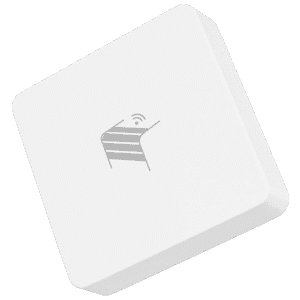
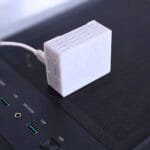
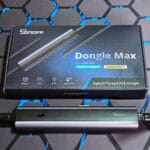
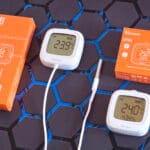
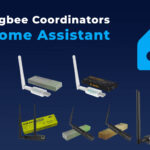
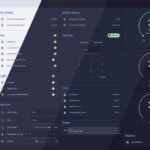
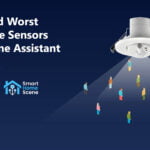

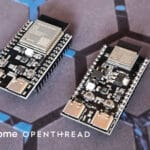

Thanks for this review.
What about fall detection in stairs ? Did you try ? Would it work in this case ?
For the heart rate one, my parents are sleeping in the same king size bed and both suffer from sleep apnea, where do I put these for monitoring their respiration and heart rate ? Under the bed ? If I use two sensors would each one be able to differentiate each person ?
Thanks for help
Regards
V.
That’s a tricky one. Ideally, you would need the sensor facing the person.
So, you would need to aim one towards one person, preferably from the ceiling.
But if they cuddle up, it WILL detect both. It will not be able to differentiate between one or another, if both are in its field of vision.
I think a wrist or chest sensor would be better, or maybe a decent smartwatch.
Do they support Zigbee/Z-Wave/BLE/Other or just WiFi?
Wi-Fi only
I bought an MR60BHA2. I’m trying to connect it to my PC, but it’s not recognized. Nothing happens when I plug it in. I do have a USB cable that manages data. When I plug it in, the light turns white and then goes off. I also do not hear any sound when connecting to the PC. Do you have any idea ?
You need to connect to the fallback hotspot the device emits and pair it to Home Assistant, just like any other ESPHome device.